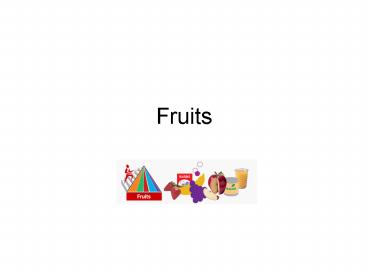Fruits - PowerPoint PPT Presentation
1 / 12
Title:
Fruits
Description:
fruit cocktail. 100% Fruit juice: orange. apple. grape. grapefruit. Nectarines. Oranges ... In general, 1 cup of fruit or 100% fruit juice, or cup of dried ... – PowerPoint PPT presentation
Number of Views:155
Avg rating:3.0/5.0
Title: Fruits
1
Fruits
2
What foods are in the fruit group?
- Melonscantaloupehoneydewwatermelon
Mixed fruitsfruit cocktail 100 Fruit
juiceorangeapplegrapegrapefruit
Berriesstrawberriesblueberriesraspberriescher
ries
3
GrapefruitGrapesKiwi fruitLemonsLimesMangoes
- NectarinesOrangesPeachesPearsPapayaPineapple
PlumsPrunesRaisinsTangerines
ApplesApricotsAvocadoBananas
4
How much fruit is needed daily?
- Daily recommendation
- Girls
- 9-13 years old
- 1 ½ cups
- 14-18 years old
- 1 ½ cups
- Boys
- 9-13 years old
- 1 ½ cups
- 14-18 years old
- 2 cups
- Women
- 19-30 years old
- 2 cups
- 31-50 years old
- 1 ½ cups
- 51 years old
- 1 ½ cups
- Men
- 19-30 years old
- 2 cups
- 31-50 years old
- 2 cups
- 51 years old
- 2 cups
5
What counts as a cup of fruit?
- In general, 1 cup of fruit or 100 fruit juice,
or ½ cup of dried fruit can be considered as 1
cup from the fruit group. The following specific
amounts count as 1 cup of fruit
6
Why is it important to eat fruit?
- Health benefits of eating lots of fruits
- may reduce risk for stroke and perhaps other
cardiovascular diseases - may reduce risk for type 2 diabetes
- may protect against certain cancers, such as
mouth, stomach, and colon-rectum cancer - may reduce the risk of coronary heart disease
- potassium may reduce the risk of developing
kidney stones and may help to decrease bone loss - may be useful in helping to lower calorie intake
because you will feel more full on less calories
7
Why is it important to eat fruit?
- Nutrients
- Diets rich in potassium may help to maintain
healthy blood pressure. Fruit sources of
potassium include bananas, prunes and prune
juice, dried peaches and apricots, cantaloupe,
honeydew melon, and orange juice. - Dietary fiber from fruits, as part of an overall
healthy diet, helps reduce blood cholesterol
levels and may lower risk of heart disease. Fiber
is important for proper bowel function. - Vitamin C is important for growth and repair of
all body tissues, helps heal cuts and wounds, and
keeps teeth and gums healthy. - Folate (folic acid) helps the body form red blood
cells.
8
Tips to help you eat fruits
- As snacks
- Cut-up fruit makes a great snack. Or, try whole
fresh berries or grapes. - Dried fruits also make a great snack. They are
easy to carry and store well. Because they are
dried, ¼ cup is equivalent to ½ cup of other
fruits. - As a snack, spread peanut butter on apple slices
or top frozen yogurt with berries or slices of
kiwi fruit. - Frozen juice bars (100 juice) make healthy
alternatives to high-fat snacks.
9
Make fruit more appealing
- Try a yogurt or pudding as a dip for fruits like
strawberries or melons. - Make a fruit smoothie by blending fat-free or
low-fat milk or yogurt with fresh or frozen
fruit.
10
Chefs Tips
- Try applesauce as a fat-free substitute for some
of the oil when baking cakes. - For fresh fruit salads, mix apples, bananas, or
pears with acidic fruits like oranges, pineapple,
or lemon juice to keep them from turning brown.
11
Keep it safe
- Wash fruits before preparing or eating them.
Under clean, running water, rub fruits briskly
with your hands to remove dirt and surface
microorganisms. Dry after washing. - Keep fruits separate from raw meat, poultry and
seafood while shopping, preparing, or storing.
12
Fresh Fruit
- .always in style!































